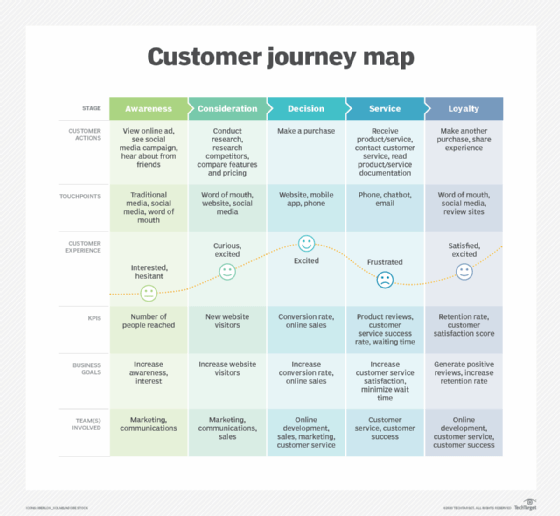5 tips for creating customer journey maps from buyer personas
Organizations can create a journey map for each buyer persona. To create the map, CX teams should use data, consider many viewpoints and apply a central governance framework.
Customer journey mapping -- the practice of diagramming stages of customers' interactions with an organization -- is an important step for CX professionals.
To create a customer journey map, CX teams must create a buyer persona. A persona is a representation of customer expectations, needs, motivations and frustrations -- a behavioral customer portrait.
While buyer personas often include some demographic data, persona does not equal market segment. A market segment is about how groups of customers live, whereas the persona helps organizations understand what makes an individual customer tick.
Organizations usually have several personas that collectively represent the entire customer base. CX teams should craft customer journey maps for each persona to address each persona's specific components.
Explore five important tips for how organizations can use buyer personas to create effective customer journey maps.
1. Tie personas to data
Sales and marketing professionals often have a strong sense of buyer persona ingredients, but anecdotal representations are too subjective and incomplete to be effective. CX teams must build personas from real behavioral data.
Organizations can collect behavioral data from several sources, such as CRM systems, surveys and analytics tools. Data from these sources can build meaningful predictive profiles that inform the journey map.
CX teams should pull together the most complete information possible and tie the resulting persona back to the data they used to create it. If teams skip this step, personas might not generate all the insights that the organization meant for it to produce.
2. Accommodate multiple views
Different features of a persona will have different uses and meanings to various teams in the business. For example, marketing teams might see a persona differently than sales teams. Personas ideally include common customer behaviors, and different teams care about different behaviors.
Organizations must accommodate these different views and share updates across teams. These updates should point out changes that might affect various teams.

3. Use centralized management
To maintain multiple views of individual personas, organizations must manage them from a common management model -- a centralized governance framework that accepts inputs from any team using the persona. This model applies shared standards to data sources, methods of mining insights and notifications of changes across the organization.
A centralized approach helps organizations align their teams, which enhances the use of personas overall. A persona management model can also open the door to serendipitous discovery if one team's new data source deepens the metrics on behaviors of interest to another.
4. Sync personas and journeys
If a change in underlying data changes the persona -- and, in turn, all its dynamic views -- then the customer journey map based on the persona will likewise change.
Personas, in combination with journey maps, become a living diorama of the customer experience. In principle, personas and customer journey maps cannot be separated, and organizations should never let separation happen through bad practice. Personas and journey maps should exist within the same environment -- two critical facets of one integrated system, updated and maintained together.
5. Fine tune data, as personas change over time
A persona initially drives journey map creation, but thereafter, personas and maps drive the evolution of each other. Changes to the data underlying the persona can move updates forward from persona to map. However, when organizations compare the anticipated customer behaviors detailed in the map to actual performance metrics from the real world, the map may drive change in the other direction.
The data is not necessarily wrong if the model doesn't perform well. It more likely means that the insights gleaned from a persona are off-base and need some fine-tuning. Organizations should frequently check how those insights perform in any case, whether shortfalls are apparent or not.
Overall, organizations should view buyer personas and the journey maps they enable like any other enterprise digital asset -- worthy of continuous review and update, rigorous maintenance and diligent governance.
Editor's note: This article was written by Scott Robinson in 2019. TechTarget editors revised it to improve the reader experience.







